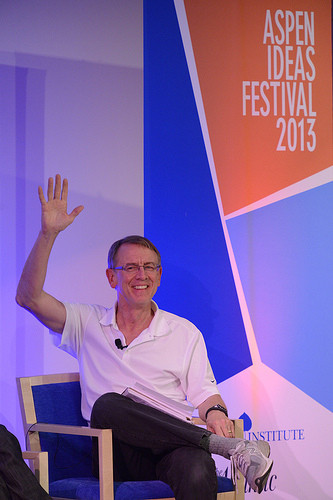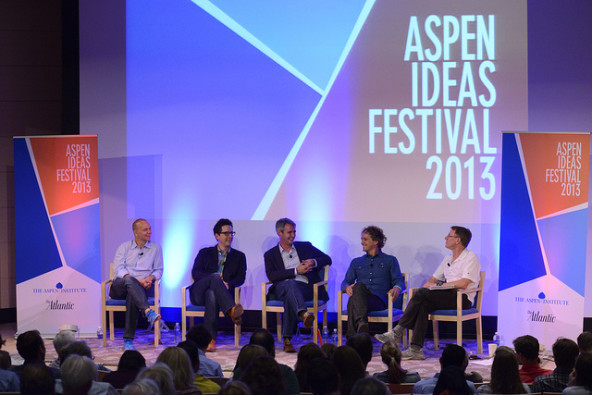 Venture capitalist John Doerr kicks off the "Designing the Human Interface" session during the 2013 Aspen Ideas Festival. (Photo courtesy of The Aspen Institute)
Venture capitalist John Doerr kicks off the "Designing the Human Interface" session during the 2013 Aspen Ideas Festival. (Photo courtesy of The Aspen Institute)
Having invested in some of the most successful technology companies in the world, venture capitalist John Doerr has amassed a personal fortune in excess of $2.5 billion and is one of the most influential voices in his field. When he speaks, money follows.
Half a dozen years ago, Doerr took center stage at the Aspen Ideas Festival—the annual convening of The Aspen Institute—to give a talk on climate change that many consider legendary. He spoke about our environment in deeply personal terms, in the name of his children and future generations. He recalled his 16-year-old daughter at the time saying, “Dad, your generation created this problem; you better fix it.”
Doerr went on to describe sustainability as the next frontier in both his personal investing and that of his firm, Kleiner Perkins Caufield & Byers, and urged others to join them. In recent years, the company has logged upwards of 75 “greentech” investments, including a few household names, such as the NEST smart thermostat.
Fast forward to today. Doerr is now shining the spotlight on another previously dark corner in venture capital: design. At this year’s Aspen Ideas Festival, which took place last week in Colorado, Doerr led a panel discussion featuring four of the most prolific design entrepreneurs of our time—Yves Behar of the industrial design firm fuseproject, iPod designer Tony Fadell (now of NEST), serial entrepreneur Mike McCue of Flipboard, and Facebook Connect designer Dave Morin (now of Path). Doerr proudly disclosed that he is an investor in companies headed by all four men.
Are you enjoying this article? Read more like this, plus SSIR's full archive of content, when you subscribe.
The market reach represented by the panelists alone was both impressive and staggering. Dave Morin estimated that one of his earlier inventions, Facebook Connect, has “literally been used trillions of times.” Prompted by Doerr to describe one of his greatest achievements, Yves Behar did not speak of his elegant Up band or tactile JAMBOX wireless speaker; he talked about his redesign of the packaging and dispensers for New York City’s free condom program, which he helped re-launch in 2008. Today, 30-40 million condoms are distributed annually in the city as a direct result. Both examples illustrate the huge reach and scalability of design.
 Session panelists (from left to right) included Tony Fadell of NEST, Dave Morin of Path, Mike McCue of Flipboard, Yves Behar of fuseproject, and John Doerr of Kleiner Perkins Caufield & Byers. (Photo courtesy of The Aspen Institute)
Session panelists (from left to right) included Tony Fadell of NEST, Dave Morin of Path, Mike McCue of Flipboard, Yves Behar of fuseproject, and John Doerr of Kleiner Perkins Caufield & Byers. (Photo courtesy of The Aspen Institute)
As star-studded and inspiring as it was, Doerr’s panel failed to include even a single female designer, which—to his credit—he publicly pointed out. When Doerr asked his panelists about the role of women in design and their companies, several spoke of women on their teams, but the responses were vague and decidedly underwhelming. None spoke of women from a leadership standpoint or compellingly about the profound value diverse designers bring, beyond a few acknowledgements that women tend to be better at marketing.
Ironically, some of the most dynamic female designers of our day were sitting in the audience—Krista Donaldson of product design and technology nonprofit D-Rev: Design Revolution, systems designers Patrice Martin and Jocelyn Wyatt of IDEO.org, and environmental design genius Marika Shioiri-Clark, who is engaged in groundbreaking work for women and girls via the Nike Foundation. Whether designing low-cost prosthetic devices, safe sanitation systems, or healing spaces for the poorest people in the world, describing these women’s unique talent as “marketing” is a costly mistake.
To be sure, the design industry is hardly alone in struggling with glaring gender equity issues. But in design, the more diverse the contributors, the wider and more representative pool of creative ideas there are to draw from—especially when designing for specific demographics such as women. Most significantly, women make an estimated 70 percent of purchasing decisions. Through that lens alone, the business case is clear.
It’s also clear that Doerr’s investments are about more than just business and profits; they’re about a better, more sustainable, more just world—again, for his children and future generations. But one has to wonder what that same daughter of Doerr’s—who he quoted back in 2007 and who introduced herself from the back of the room last week as a student at Brown University—might have thought when listening to a discussion about the transformative power of design without the presence of even a single woman looking back at her.
The representation of women in design is not the responsibility of women but of all of us. That includes and arguably starts with design gurus such as Behar, Fadell, McCue, and Morin, as well as crucial catalysts like John Doerr. As Doerr increasingly invests in design-driven companies and products, he can specifically look for and call for gender-balanced leadership teams. When he leads, people follow. He can also seek out, invest in, and mentor women-led entities, starting with those cited above.
Support SSIR’s coverage of cross-sector solutions to global challenges.
Help us further the reach of innovative ideas. Donate today.
Read more stories by John Cary.

